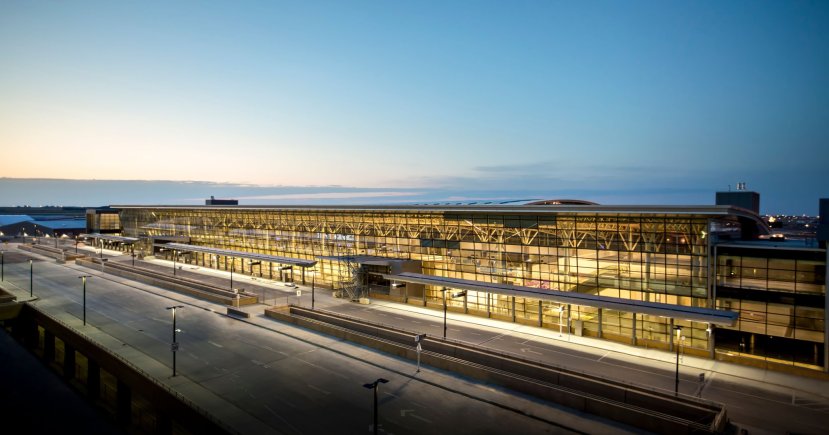Airport chief executive expects user fees will increase, even if the airport receives government help

What if an airport infrastructure project could create jobs and help Canada kick-start the pandemic-ravaged economy? Would governments buy in?
That intriguing notion was put Tuesday by Bob Sartor, the President and Chief Executive Officer of Calgary International Airport as he pleaded for government relief to help the airport weather the COVID-19 pandemic.
“We need tailored government help to ensure the long-term viability of the airport Calgarians and Albertans rely on for the safe and secure passage of people and goods,” Sartor said at a news conference following the airport’s Annual Public Meeting.
Like all airports across the country, Calgary has been hit hard by the pandemic, though the blow was softened somewhat by Westjet’s large operations. At one point in April, Calgary was the busiest domestic airport in the country, thanks to Westjet’s strategy of funnelling traffic through its busiest hub, a strategy that has intensified as airlines start to reopen flights.
Passenger numbers were down 95% in April and May, said Sartor, and down 90% in June. Calgary now expects to handle 6.4 million passengers in 2020, down from almost 18 million last year. “At those levels, there’s some pretty serious bleeding going on, not only for us but for the air carriers, all of our tenants, and a wide range of people,” said Sartor.
Traffic has started to pick up in July, with Westjet now flying more than 50 departures from Calgary every day, including its first flights to Los Angeles, Atlanta, and Las Vegas since March. Air Canada has scheduled more than 20 daily departures, though that capacity is still nowhere near what it was before the pandemic’s impact was felt.
Sartor said Calgary International is projecting a deficit of $67 million in 2020. That is on top of losses of $60 million last year, $144 million in 2018, and $142 million in 2017 as the airport wrapped up a major terminal and runway expansion. That adds up to more than $400 million in losses in the last four years as the airport struggled to keep up with a surge in passenger traffic.
“To survive this period of time, to get to a place where we will be profitable and be able to sustain our debt level, really we’ll probably have to borrow somewhere around a quarter of a billion dollars to do that,” said Sartor.
That would be added to the airport’s debt which already stood, at the end of 2019, at a whopping $2.9 billion, more than the debt owed by Prince Edward Island. Across Canada, data compiled by Western Aviation News show the 21 largest airports owed $15 billion at the end of 2019, and spent $664 million just to service the debt.
Calgary’s debt per enplaned passenger – an indicator of an airport’s financial health – stood at $322 last year, second only to Quebec City. Debt service ate up one of every five dollars in 2019, almost triple what the airport spent on salaries. The pandemic will only make that worse.
To make up the loss, Sartor warned user fees – such as those charged to airlines for using the airport or those charged directly to passengers in the form of Airport Improvement Fees – will rise, though he couldn’t say when or by how much. Invariably, those fees will lead to higher airfares.
“Every day we open, we bleed,” said Sartor. “We have to stay open. This is a vital infrastructure asset, we have no choice.”
Calgary, like most of Canada’s busiest airports, is run by a private, not-for-profit authority that receives no money from government for either its operations or capital projects. In fact, governments collect millions a year in land lease payments and property taxes. Sartor said it’s time for that equation to change.
“Since the authority took over the operation of YYC from the government of Canada in 1992, the federal government has always financially benefited each and every year from our airport operations through rent,” he said. “It is now time for the government of Canada to do the right thing and waive the rent for the next five years.”
On top of rent relief, Sartor called on the government to offer interest-free loans, calling current government programmes of “little use” for Calgary. So far, no airport has signed on for government loans of last resort to survive the pandemic.
He would also like to see government infrastructure investments to kick-start the sector – and the economy – once the pandemic eases.
For instance, Calgary’s runway 17L/35R is 40 years old, and due for refurbishing. A pandemic, when people are hurting for work and flights are way down, would be a perfect time to close the runway for a major rehabilitation. But the project would cost in the tens of millions of dollars, far more than the airport can afford right now.
“It is absolutely critical to us expanding and growing our business in the future,” he said. “We likely could not do 18 million passengers in the future off of one runway along with all of the cargo given our growth rate.”
Sartor expects it to take anywhere between three and five years for Calgary to return to its record passenger numbers of 2019. He said much will depend on how safe people feel travelling for business, holidays, or to see loved ones. “Sentiment is critical. We could have the best sanitized airport in the world here,” he said. “If people are uncomfortable, they’re not going to come to the airport and they’re not going to buy.
“We need to learn to coexist with COVID.”
While you’re here
Would you consider making a one-time or ongoing donation? We’re an independent voice for and about Canadian aviation. We want to keep the site free to share our passion with the world.
We survive thanks to the support of readers like you.
1 reply »